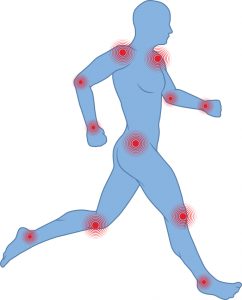The Ultimate Guide to Preventing and Treating Tendinopathy
 Among all kinds of athletes, both professional and recreational, tendinopathy (also known as tendinitis) is one of the most common injuries.
Among all kinds of athletes, both professional and recreational, tendinopathy (also known as tendinitis) is one of the most common injuries.
About one-third of runners suffer from Achilles tendinopathy, as will approximately 14 percent of volleyball players. Soccer players are also susceptible to tendinopathy, and athletes who frequently participate in overhead maneuvers (serving, pitching, etc.) are four times more likely to deal with tendinopathy compared to other athletes. Kobe Bryant famously tore his Achilles tendon in 2013 in a game against the Golden State Warriors, sidelining his season for nearly 8 months.
If you play one of these sports, or are an active person in general, it’s important to understand what can be done to prevent and treat tendinopathy. Read on to learn more about this condition and the steps you can take to keep it at bay while you continue to play your favorite sports.
What is Tendinopathy?
Tendons are tissues that connect the muscles to the bones. They bear the weight of muscles and allow the joints of the body to move freely.
Tendinopathy occurs when the tendon becomes inflamed. Repetitive motions — swinging a tennis racquet or golf club, for example — often cause tendinopathy in athletes.
The most common sites of tendinopathy include the shoulders, biceps, and elbows (tendinopathy of the elbow is often referred to as tennis elbow).
Common Tendinopathy Symptoms
Pain is the most common symptom of tendinopathy, and that pain typically gets worse when the inflamed tendon is moved. The skin over the tendon may also be red and/or warm to the touch.
If you do are suffering from tendinopathy, the location of your pain will vary depending on the area of inflammation.
For example, tendinopathy of the biceps will usually be accompanied by pain in the area where the arm meets the shoulder. You’ll probably feel the greatest amount of pain when you flex your elbow to create a 90-degree angle and turn your hand so your palm faces up (supination).
Tendinopathy of the elbow, or tennis elbow, on the other hand, is usually accompanied by pain in the elbow that’s made worse when you extend your wrist and bend it back toward your body.
Preventing Tendinopathy
When it comes to preventing tendinopathy, a proper warm-up and cool down are essential.
Taking time to warm-up the body before playing your sport of choice will help you avoid putting too much strain on the tendons.
A good warm-up will include some light cardio (jogging or walking) followed by dynamic stretches (these are stretches that move the joint through a continuous range of motion).
When you’re stretching before a game or practice, be sure to spend plenty of time focusing on the joints that get the most work. For example, if you’re a runner, you’ll want to dedicate the bulk of your warm-up to the Achilles tendon, while tennis players should work on warming up the elbow and shoulder joints.
As for your cool down, spend some time walking or lightly jogging to bring your heart rate down. Then, static stretch (hold stretches for an extended period of time) or foam roll to increase blood flow to the muscles and promote healing.
Some other steps you can take to prevent tendinopathy include:
-
Avoiding over training and pushing through movements that cause old injuries to flare up
-
Strengthening the muscles surrounding susceptible joints and doing exercises designed to improve mobility
-
Using special splints or braces for doctor-approved compression treatment that will help stabilize old injuries
Treatment Options
If you are already struggling with tendinopathy, these tips will help you treat your condition properly and get back to your sport as quickly as possible.
-
Ice and immobilization
-
Alternating between ice and heat to prevent stiffness
-
Using nonsteroidal anti-inflammatory drugs (NSAIDs) to reduce swelling
-
Stretching and mobility exercises to avoid scar tissue buildup
In some cases, working with a physical therapist or personal trainer can be a helpful treatment option, especially if you’ve been dealing with a particularly stubborn case of tendinopathy.
Conclusion
Tendinopathy is a highly common sports injury, and many athletes — especially golfers, tennis players, and others whose sport involves lots of repetitive motions — suffer from it every year.
Athletes should keep these tips so they can either avoid tendinopathy or treat it appropriately, which will shorten the amount of time they spend sidelined.